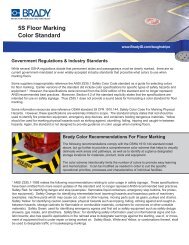INTRODUCTION OBJECTIVES - Plant Services
INTRODUCTION OBJECTIVES - Plant Services
INTRODUCTION OBJECTIVES - Plant Services
- No tags were found...
You also want an ePaper? Increase the reach of your titles
YUMPU automatically turns print PDFs into web optimized ePapers that Google loves.
Chapter 4 — Hydraulic Pumps 111Positive-DisplacementPump OperationAll positive-displacement pumps operatesimilarly to create fluid flow. Therefore, theprinciples of positive-displacement pumpoperation can be applied directly to thedifferent types of positive-displacementpumps encountered in the field. All hydraulicpositive-displacement pumpshave similar parts such as a shaft, pumphousing, inlet port, and outlet port. SeeFigure 4-8. A positive-displacement pumpoperates in four basic steps:1. The pump creates a vacuum by increasingthe volume at its inlet, which is connectedto the reservoir. Vacuum is created in aconfined space that has less pressure thanatmospheric pressure. The vacuum in apump is created when the pump rotatesand an increased volume is created at itsinlet. The pressure in the tank is at atmosphericpressure, which is higher than thevacuum created at the inlet. Atmosphericpressure forces the fluid to flow from thetank into the inlet of the pump.2. Once the fluid enters the pump throughthe inlet, the pump traps the fluidthrough a sealing method. A seal is anairproof and/or fluidproof joint betweentwo members. The fluid travels throughthe pump, in decreasing volume, towardsthe outlet side of the pump.3. Once the trapped fluid moves towardthe outlet side of the pump, the sealedchamber opens and releases the fluid intothe pump outlet.4. The sealed chamber then closes, preventingfluid in the outlet side of thepump from slipping to the inlet side ofthe pump. At the same time, more fluidis forced out of the outlet and into thehydraulic equipment.TECH FACTPositive displacement, as it relates tohydraulic pumps, means that regardless ofthe load or speed involved with a hydraulicsystem, the pump will always displace thesame amount of fluid per shaft revolution.1FLUID FLOWS FROMRESERVOIR TO PUMPFROMRESERVOIRFROMRESERVOIRFROMRESERVOIRPositive-DisplacementPump Operation 4-8PUMP ROTATIONINLET PORTATMOSPHERICPRESSURERESERVOIRHYDRAULICFLUIDTO HYDRAULICEQUIPMENTTO HYDRAULICEQUIPMENTTO HYDRAULICEQUIPMENTTO HYDRAULICEQUIPMENTFigure 4-8. All positive-displacement pumps follow the same basic operationalsteps to create fluid flow.2SEALPOSITIVE-DISPLACEMENTPUMPOUTLET PORTPUMP HOUSINGCHAMBER CAPTURESHYDRAULIC FLUID ANDCARRIES THROUGHPUMP HOUSING34CHAMBER OPENSAND RELEASESHYDRAULIC FLUIDINTO OUTLETCHAMBER CLOSES,PREVENTINGHYDRAULIC FLUIDFROM SLIPPINGBACK TO INLET












